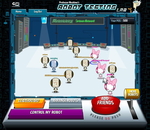Dashboard Rock Could Excel a Bit Better at Rocking
Posted in: Uncategorized
Dashboard Rock, which represents Mazda’s attempt to cash in on the popularity of games like Rock Band and Guitar Hero, is a lot like Dance, Dance Revolution for your fingers. Also, you can download 15 songs as you move through the game.
Coins Shot, Creative Boxed, Coal Hyped, Game Trailered
Posted in: Uncategorized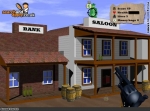
Hey if shooting’s your thing, Wild West Coinfest might be to your liking. It’s for something.
Homo Ludens Ludens – A conversation with curator Daphne Dragona
Posted in: Uncategorized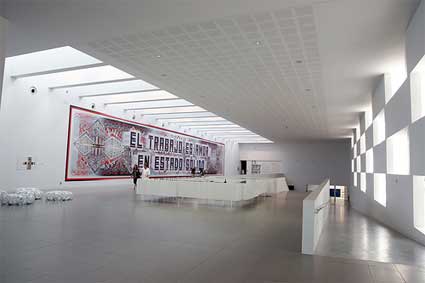
LABoral (inside) mural by Mark Titchner. Image courtesy of LABoral
Together with Erich Berger and Laura Baigorri, Daphne Dragona curated Homo Ludens Ludens, an exhibition about play in contemporary culture and society which runs until September 22 at LABoral, Spain. I’ve been blogging the exhibition over the past few days but i wanted to end the coverage with a couple of questions to Daphne.
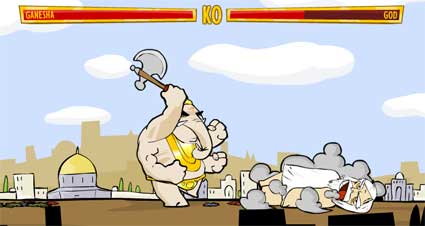
Daphne Dragona is an independent new media arts curator and organiser, based in Athens with a special interest in the game arts field. She was the Programme Curator of Gaming Realities (Medi@terra, International Art and Technology Festival) which took place in Athens in 2006, and the Associate Curator of Gameworld which was hosted in Laboral in 2007. She has been involved as an organiser or as a participant in different new media events and since 2004 she is also collaborating with the International New Media Collective Personal Cinema.
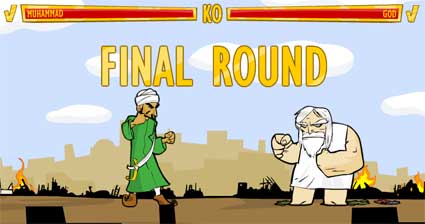
Molle Industria, Faith Fighter
Following Gameworld and Playware, Homo Ludens Ludens is the last episode of a trilogy dedicated to the world of game. How different is HLL’s take on the theme of games and play?
We wanted Homo Ludens Ludens to embrace the previous concepts and summarize them somehow. To do this we needed to take in a way a step back, to look into play rather than games, to locate play’s role and significance into the different sections of our society and culture. The two previous exhibitions, Gameworld and Playware focused respectively on the creativity of gaming art and on the playfulness of interactive art. Homo Ludens Ludens tried to locate and present play as a power and a medium that is embodied in different sections of our lives, that can ask questions, reveal facts and bring changes.
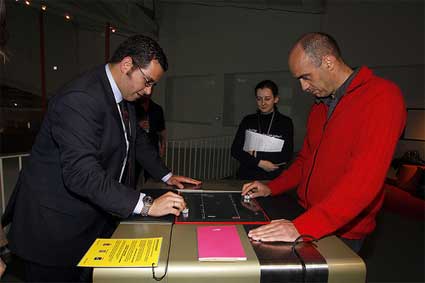
PainStation. Image credit: LABoral/Enrique G. Cárdenas
HLL presented 4 different themes: previous art movements which incorporated play in their discourse, play in everyday life, contents which invite to reflect on political and social issues and finally an introspective look on games and video games. Why did you decide to adopt such a broad approach?
Well, truth is that there are much more themes being discussed. We referred to these 4 categories at some point because the need appeared, as it happens for all exhibitions, to speak of a particular kind of structure. But in reality we were against the idea of grouping and categorising. Works can be categorised according to this scheme or some other schemes. The form of the exhibition is quite fluid actually, with no rigid clusters and units. To come back to your question, yes the theme is broad, but the issue of play in our digital times is huge anyway. Naming the event Homo Ludens Ludens was in a way an intro for a broad approach. Huizinga was already talking about the diffusion of play within culture back in the late 30s. We wanted to explore and present how things have changed, flourished and altered since then; to bring in as many aspects as possible through our exhibition and our conference. There have been a lot of misunderstandings regarding play nowadays: for instance, you speak about play and everyone things you refer to videogames, you refer to play and the issue is considered merely joyful, entertaining and lacking content. We wanted to escape from this, to present play’s multifaceted character and raise consciousness about it. So, the approach could have been even broader, but maybe then the risk of its good presentation and perception would be higher.
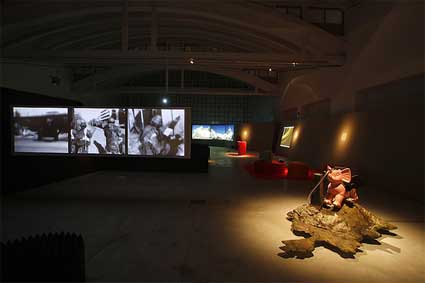
Image courtesy of LABoral/Enrique G. Cárdenas
Which strategies did you adopt to have works which have very different backgrounds and characteristics (the interview with Muciunas, the installation levelHead, the Objects of Desire chase, etc.) cohabit and dialog with each other? You and your fellow curators Erich Berger and Laura Baigorri must have met with many challenges when preparing such a big and multi-faceted show. How did you manage to keep your head(s) above the water?
I would not really speak of strategies. Let’s say that we located the areas of our interest on one hand, and works we consider interesting and inspiring on the other. We knew that we wanted to have a show that would be playful and critical at the same time. The criterion for all cases of works was not their form, for instance to be game applications as it happens in most game art shows, but rather their playfulness, their ludic mode and the ability to express different situations and notions through it. There were no constraints regarding any types of works – the exhibition was to be explored as a territory, a playground of various contemporary magic circles. This is maybe where the challenge and the difficulty was: trying to avoid usual paths and groupings that exhibitions tend to follow and still aiming to have a perceivable context and content. This is how we came up with dialogues and adjoining of certain works that were implied but not explained or framed. I believe that this kept the flow much smoother and more open.
So this way, for example, Wegman‘s dogs could go next to Stockburger‘s Tokyo gamers to show play’s omnipresence and utter seriousness; Ludic Society‘s chase based on the desires of particular objects and Savicic’s wifi map of gijon as read by his special corset could be adjoined by a magnified copy of Debord‘s psychogeographical map of Paris; Klima‘s pink elephant on the war of Afghanistan could sit next to Sanchez’s Atari modification for the civil war of Peru.
Regarding the references to the old movements of the fluxus and the situationists we felt like we ought to include them, not only as a “tribute” to them but also as an additional element for the audience to perceive the contemporary works we present. For instance, it is important to see that certain notions that are presented in this show such as those of the transdisciplinarity, the appropriation, the detournement, the idea of highlighting the importance of everyday life as opposed to art, they all have their roots way back, in important modern movements.
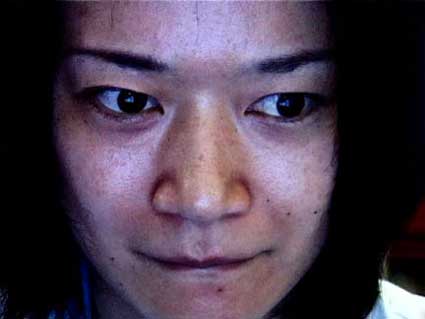
Axel Stockburger, Tokyo Arcade Warriors – Shibuya (2005)
Many of the works on show at HLL demonstrate a keen observation of the rules and mechanisms of commercial games but do you think that the opposite is true? Have you ever noticed any interest from the commercial scene for what artists are doing with the game medium?
My understanding is that they do follow what happens in terms of creativity. The innovations and the approaches that are often introduced by artists and independent creators are of their interest either in terms of design, content or programming. And they do tend to hire artists often as part of their team, which makes sense of course. But on the other hand, judging from my experience, game companies still hesitate to support game art exhibitions, festivals and conferences. The commercial and the independent/artistic scene have not really merged yet. Probably they are not meant to merge, if we take what happened with cinema as an example. Different works and productions attract different audiences. Not a lot of gamers go to game art exhibitions for instance. The audience for these shows is mainly people interested in the arts and the technology. But at the end, it all works perfectly well for the industry as games are assigned new roles and are being accredited new values. This is the tricky point. As Auriea Harvey and Michael Samyn had said, how about if the artistic / independent gaming scene at the end becomes the alibi for the commercial one to keep its character intact?
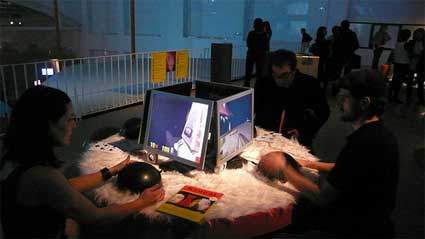
France Cadet, SweetPad
If i’m not wrong, you distinguish play from game. Can you explain us what makes them different from each other?
Yes, we tried to make this distinction visible in Homo Ludens Ludens, although there is no “formal” differentiation between the two terms and there is of course a lot of overlapping. In reality, it is easy to describe games but rather difficult to frame play.
I would say play reflects more the idea, the notion, the vivid and spontaneous basis for the action as well as its relation to fantasy, whereas games are closed systems and environments governed by rules which demand discipline and a constraint space and time. Play is in a way the presupposition for the games that are its expressions and forms.
Play as a notion is much more open and therefore it may even embrace elements that come in opposition with a game’s structure. For instance play has no death or end; but games do, otherwise there s no meaning into it. Or think of cheating. While it can destroy a game by breaking its rules, it is still a part, an act of play. On the same line, while any game forms hierarchies, play creates interrelations between them.
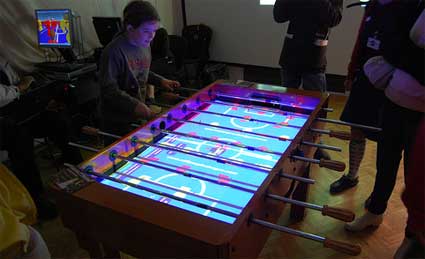
MIT Lab – Drew Harry, Dietmar Offenhuber, Orkan Telhan Stiff People’s League
It is all up to the play instinct I guess. We can be playful anytime anyplace, not only through games. Games are basically a construction which is made possible because of this playfulness that already exists in any aspect of life.
Nowadays, with the explosion of the videogame industry games have also become a product, a commodity and a subject of control. Accordingly, play became work and life itself started looking more like a complicated game environment. So the question is what happens with the notion of play at such times? This is really interesting: how we have been led from the total invasion of play that the situationists were dreaming of to the gamespace phenomenon Wark describes.
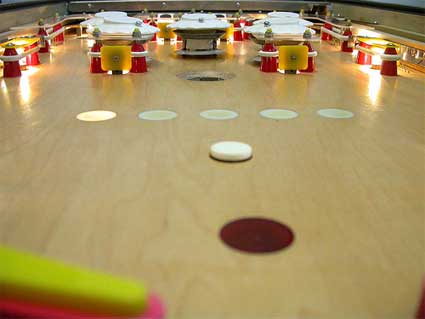
Martin Pichlmair & Fares Kayali Bagatelle Concrete
What is your personal relationship with video games? Are you a gamer yourself?
I mostly enjoy following what s happening in the online virtual worlds and trying out practices and applications by the independent and artistic scene. I also do try to keep up with the commercial games popping up but sometimes this is not so easy in terms of time and energy. Generally, however, if you ask me about the last months, I must say that -maybe influenced by homo ludens ludens- I also got carried away and inspired by other types of play; from children’s make believe play to play being approached by philosophy as a tool for political change… This practically means that I really liked playing a lot with my 2 year old niece on one hand and reading Agamben and Vaneigem on the other. It was quite a weird combination now that I think about it…
Thanks Daphne!
Adidas Original Games – the playable games
Posted in: UncategorizedI’m a huge fan of the idea behind the “original games” campaign. Cafe ping pong & street fencing are genius. The 180 Amsterdam commercial (below) produced by Stink (London) piqued my interest.
And with concept that grabs my attention as much as this one, I was hoping for a bit more than some playable computer games. And while the Skate-or-Die-style of game is cool, there’s still a bit of a disconnect for me from the true idea behind it all (or at least what I hoped the true idea would be). Still a cool execution, but I hope these games aren’t the finale of the “original games” concept… it seems to have so much potential.
(I was going to embed one of the games, but this site’s formatting shrinks it down and messes up the flash a bit, so click the image above to be taken to the Adidas site to best experience the games.)
Numa Numa Dude Blocks iJustine From Chat
Posted in: Uncategorized
Apparently, Gary didn’t like what Justine had to say in the chat room so she was slapped with the message “ijustine was blocked from the chat for inappropriate behavior.”
Homo Ludens Ludens – Gold Farmers
Posted in: UncategorizedThe documentary i was dying to see at the Homo Ludens Ludens exhibition at LABoral in Gijon was Gold Farmers, by Ge Jin.
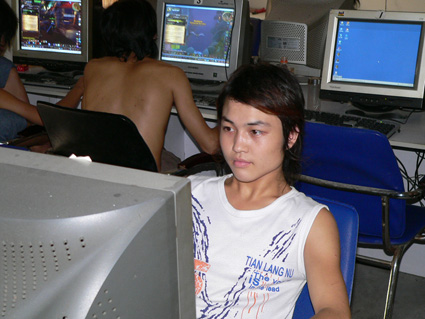
Image courtesy of Ge Jin
Gold Farmers are young people who earn their living by playing MMORPG games. They acquire (“farm”) items of value within a game, usually by carrying out in-game actions repeatedly to maximize gains, sometimes by using a program such as a bot or automatic clicker.
They sell the artificial gold coins and other virtual goods they’ve harvested to players and/or farming organizations and get “real” money in return. Players from around the world will then use the golden coins to buy better armor, magic spells and other equipments to climb to higher levels or create more powerful characters.
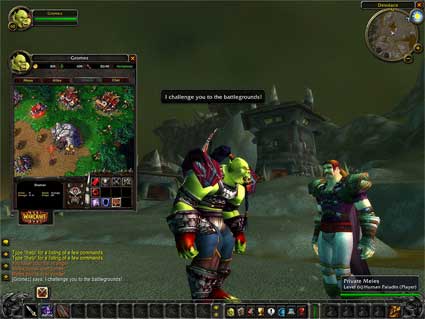
World of Warcraft, image gameslander
Many companies have attempted to block the use of gold-farming services by specifically stating in their End User License Agreements and Terms of Service that any and all game assets (from the player’s characters themselves, to any items that they may be carrying) remain the sole property of the company itself, and taking aggressive action to close the accounts of any that are found to be using gold-farming (or similar) services.
Although there are gold farmers or gold farms in countries like the Philippines, Indonesia, and Mexico, Chinese are by far the most dynamic. There, young players typically work twelve hour shifts, with just a lunch break somewhere in the middle.
There are gold farmers or gold farms in other countries as well, such as the Philippines, Indonesia, and Mexico. However, they do not approach the scope and scale of the Chinese farm industry.
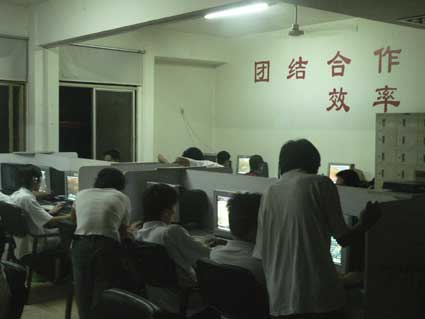
Image courtesy of Ge Jin
Ge Jin, a 30-year-old Shanghai native and a Ph.D. candidate at the University of California, San Diego, has shot a Gold Farmers, a documentary that delve into the background and lives of Chinese gold farmers.
Gold farming puts down the mechanisms that govern a universe in which everyone starts at the same level, no matter how rich their parents are, no matter how many degrees they’ve collected at the university. Players trying to work their way up according to the rules and in all fairness are the ones who get hit hardest by the practice of gold farming.
Watching the documentary, you can’t help but feel some compassion for the gold farmers: they have very little free time, they are paid quite poorly to feed the whims of the Western consumer, they have to deal with the ire of a family who doesn’t approve of what they do for a living, they must face the hostility of other players as soon as these realize that gold farmers are on their turf, their english is not good enough to enable them to communicate with other players, and they work hard. Don’t be fooled, they don’t sit there for hours just for the fun, most of their activity is extremely repetitive. In fact they would sometimes end their day at the “factory” by playing a real game in WoW. Just for the fun.
Chinese Gold Farmers Preview video (Ge Jin has uploaded more video previews):
I asked Ge Jin to discuss his documentary for the blog:
First of all, is the video on show at laboral only part of the documentary you are making or is it the full version of it?
I have another 40 min. long version, but this one is complete in itself as a short version.
Gold farmers have the challenging task of constantly navigating between clandestinity and the need to advertise their service. i suspect that finding and getting the “gold farmers” to talk must have been difficult. how did you locate the players and how did you gain their trust?
It is indeed difficult to get into the exclusive “gold farming” circle. But I was lucky to have an old friend in Shanghai who was running gold farms from 2003 to 2005. This friend introduced me to some gold farm owners. But the reason that the gaming workers/gold farmers trusted me was mainly because I treated them with respect. They face discriminations from non-gamers who see them as game addicts who are losers in real life as well as discriminations from gamers who think they care about more about money than gaming itself. I tried to be a good listener for them and they can see I didn’t approach them with many assumptions.
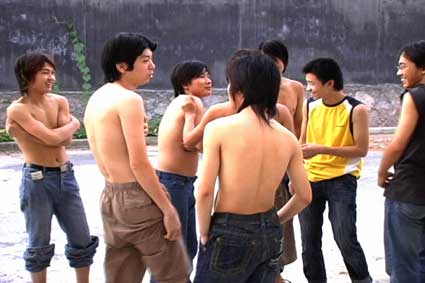
Image courtesy of Ge Jin
How much has the phenomenon evolved since you started working on this documentary in 2005 (it think)?
Yes I started following this phenomenon since 2005. I think the market become much more competitive and the profit margin for gold farmers are much smaller now. Meanwhile, more sophisticated services like power-leveling have become the mainstream of real money trade. Also, the domestic demand for in-game goods in China has risen so much that Chinese gold farmers no longer just work in foreign games.
In your documentary, you are neither pointing the fingers to gold farmers and saying “look this is evil!”, neither are you saying that this is kind of labor embodied in play is the best thing that happened to the gaming scene. I had the feeling that you are not taking a stand. Am i right?
You are right that I’m not taking a stand. And I try to let the people involved in real money trade to tell their own stories in my documentary. But I think some of my “biases” do make their way into the documentary. For example, I don’t really care if real money trade changes the regular gaming experience, I’m more concerned with how people’s virtual life and real life affect each other, so you don’t hardly hear the game industry’s point of view in my documentary.

Image courtesy of Ge Jin
Is gold farming regarded differently in China than it is in the USA, Europe or Japan for example? Is the practice seen as more acceptable by the public and the government? How much does China try to tax and regulate the business?
Culturally, real money trade is indeed more accepted in China than in other countries. For example, the successful game Legend from Giant. Ltc thrives on incorporating real money trade in game design. Western game companies dare not do so blatantly because many gamers may think the game is not a level playing ground that way. But the Chinese gamers seem to accept this inherent unfairness, as if they see so much injustice in real life that they don’t expect the virtual world to be better. The government doesn’t seem to have any problem with the gold farming business. It has not figure out a good way to tax virtual trade yet, in some rare cases, some gold farms pay a fixed amount of tax based on very rough estimation of trade volume. There is currently no policy directly regulating this industry. Though there are regulations generally aiming to purify content of games and limit how long people can play online games.
Did your research on gold farming sparkle the interest of Western commercial gaming companies? Asking your help to crack down on farmers? Or asking for your opinion on how to make the most of this new form of economy?
To my surprise, I was contacted by gold selling websites who want to use my website to advertise themselves, by gold buyers who are looking for a steady supplier, and by market researchers who want to measure the supply and demand of gold trade. I wish I could seize such opportunities to make some money for myself. But unfortunately I was occupied by exploring the social implications of this economy.
Thanks Ge Jin!
Another documentary part of Homo Ludens Ludens is the fantastic 8 bit movie.
More WoW stories: The Avatar Machine, Joichi Ito on WoW, Life at the gamers’ farm.
Homo Ludens Ludens – Desire
Posted in: UncategorizedWhile i was at LABoral visiting the Homo Ludens Ludens exhibition, i got to live the uncanny experience of being bossed around by wooden boxes that deliver Situation(ist) quotes, order me to bring them to their friends (which were also boxy and made of wood), carry them upstairs within 30 seconds, and treat them like princesses. I felt like a puppet in the hands of Objects of Desire, the latest game of Ludic Society. This international association of artists, game practitioners and theorists seek to provoke a new artistic re/search discipline, best addressed as ‘ludics’ (cf. some of their previous works: Tagged City Play for Real Players in Real Cities and The Pong Dress).
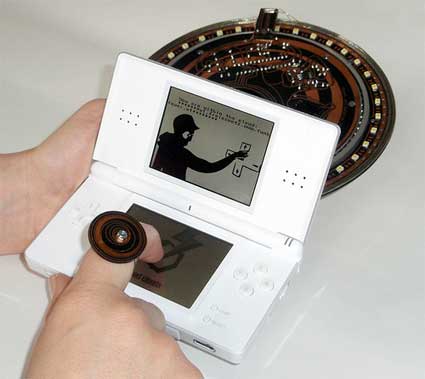
Objects of Desire is a Neo-Situationist’s walk in the company of capricious spimes through an invisible city of electromagnetic waves. The play-map constitutes of real names of wireless access points, found during a “WIFI-Sniff” through the city of Gijon. Names of actual urban WIFI zones (my favourite was called Familia Alvarez) are mapped and tagged like street-names in the exhibition space while aether waves with the same subjective names are also superimposed on the arts space, as playground.
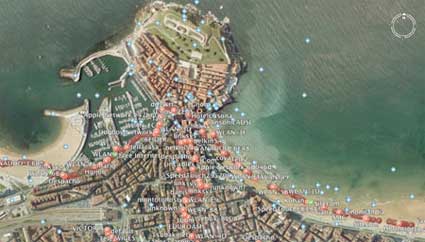
Instead of writing down what the game is about, i’ll just send you to the video of the game . It clearly explains the developments, mechanics and rules of the game. And because the plot unfolds in sunny Gijon and LABoral, you’ll also get an idea of what both the city and the art center are like.
I asked Ludite Margarete Jahrmann (who developed the game together with Fleshgordo, imonym, Rene Bauer,
and MosMaxHax) to give us more details about their game:
How does the game work technically? Does it use rfid?
Yes, each object is tagged with a RFID tag. Our self-built LS-Gerät can sniff each box and based on the RFID number and cabbalistic numerology rules the object’s desire will be appointed.
On the other side, we hide a couple of WIFI network clouds (some openWRT hacked linksys routers) in the exhibition space by which each player is located through the built-in WIFI function of Nintendo DS. The clouds are named and geographically located like access points in Gijon-city.
Basically, it is a very speculative motion tracking, like a triangulation with cell phones, virtual and real. Anyhow we used them as an inverse surveillance for each player. Each move is logged 😉
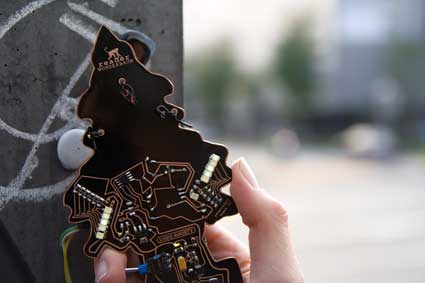
The Ludic extensions of SM (standard model) game consoles are extremely beautiful. How exactly do you craft them? Does each shape correspond to a particular function?
They were all DIY self-built and designed in our LSCV (Ludic Society Chapter Vienna). The design is conceptually connected to our ideas of a PCB – ‘Pata Circuit Boards – which are standing for Imaginary Machines and Devices of Wonder (read more about in issue#1 of LS magazine).
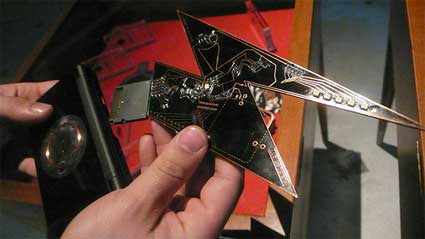
Each LS-Reader is equipped with a voltage booster, a Wunschmaschine, not only referring to our concept but also in Real by literally lifting the supply voltage up from 3 to 5 Volts. Each shape corresponds to a different conceptual starting point. The little tree refreshes the EM (electromagnetic) aether while the “Blitz” refers to our notion of BlitzPlay (Urban Guerrilla Street Play Tactics – TAZ). The circular shaped PCB is a sequel of our LudicWheel, a living machine, built for playing the game- and the reality engine either-way.
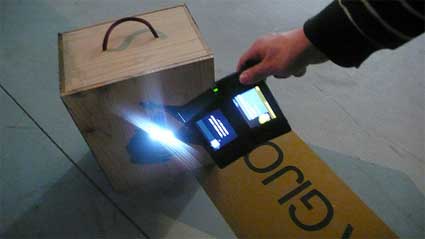
What is the story or motivation behind the objects’ stories and desires?
Playtarget: inverse surveillance by mobile toy-gadgetry…walks between WIFI and RFID waves-.. the city waves in Gijon – site specific metaphors…
Some parables between the electromagnetic waves of a city and the waves of the sea…
Then about the inverse control of objects by subjects – a domination and surveillance PlaySurVeillance 😉 by “Subjectivated” objects… with eeach RFID tag, the internet of
things gains more power. The boxes are just placeholder for any commodity or tagged object…
Based on what you could observe while you were in Gijon, how did people react to the uncanny experience of being bossed around by wooden boxes?
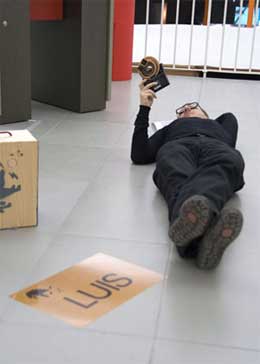 It was funny to watch people how exciting they became by obeying some very simple instructions, just for the sake of getting some points on a virtual screen. Some were lying on the floor (even the curator Erich Berger), standing against the wall for a minute or shouting out loud.
It was funny to watch people how exciting they became by obeying some very simple instructions, just for the sake of getting some points on a virtual screen. Some were lying on the floor (even the curator Erich Berger), standing against the wall for a minute or shouting out loud.
But with each game, it depends on the *player’s obedience* to the rules.
The readers are new bachelor machines to extend the Standard model game
console.
Originally we (in that case me and 3 more Ludic Society members – PM ONG, Fleshgordo and imonym in conjunction with marguerite charmante) thought about making a game through the whole exhibition- with objects tagged – which have certain behaviours — the visitors shall bring them to their “natural born home” of the Objects (OOH) which is stored in the RFID tag of the object…), we wanted to further develop Ludic Society’s urban games into a white cube test area.
Thanks Margarete!
Previous posts about the exhibition in LABoral: Homo Ludens Ludens – Play in contemporary culture and society, the Art of War.
Gitar Hero-Like Game Offers Chance to Win V Festival Tickets
Posted in: Uncategorized
It’s like Guitar Hero on your computer!
Guitar Hero-Like Game Gives Chance to Win V Festival Tickets
Posted in: Uncategorized
It’s like Guitar Hero on your computer!
Homo Ludens Ludens – Play in contemporary culture and society
Posted in: Uncategorized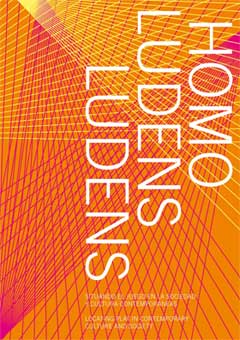 As promised two days ago, here’s more details about Homo Ludens Ludens, a new exhibition which reflects on the various roles fulfilled by play in our digital era. Homo Ludens Ludens opened on April 18 at LABoral the Center for Art and Industrial Creation which means that i was back in Gijon, Asturias, land of monster squids, rosy cheeks, deep-fried and vegetable-free diet, gorgeous landscapes and sidra thrown all over your favorite sneakers.
As promised two days ago, here’s more details about Homo Ludens Ludens, a new exhibition which reflects on the various roles fulfilled by play in our digital era. Homo Ludens Ludens opened on April 18 at LABoral the Center for Art and Industrial Creation which means that i was back in Gijon, Asturias, land of monster squids, rosy cheeks, deep-fried and vegetable-free diet, gorgeous landscapes and sidra thrown all over your favorite sneakers.
Homo Ludens Ludens is the last episode of a trilogy that LABoral is dedicating to the world of game. Following Gameworld and Playware, HLL explores play as a key element of today’ s world, highlighting its necessity for our contemporary societies. There are more than 30 works on show, so you can expect several installments about Homo Ludens Ludens.
The title of the show, Homo Ludens Ludens , alludes to the taxonomy of human evolution. The human being used to be regarded as a Homo faber (man the smith or man the maker in latin) for the control they could exert on the environment through tools.
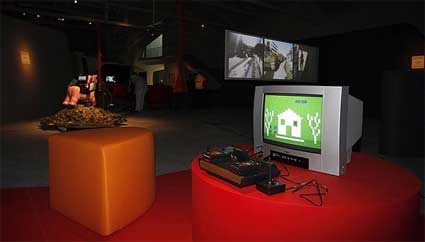
Image credit: LABoral/Enrique G. Cárdenas
In 1938, however, Dutch historian Johan Huizinga introduced the idea that man is also an Homo Ludens (a “playing man”), a man for whom amusements, humour and leisure played an important role in both culture and society. Philosopher Vilém Flusser went further. For him, we are living in a society which, instead of working, generates information by playing with a technical apparatus, implying a transition from the myth of the creator towards a player. Playing can therefore be regarded as an act of emancipation.
The exhibition speculates on the emergence of a Homo Ludens Ludens – the contemporary player of games.
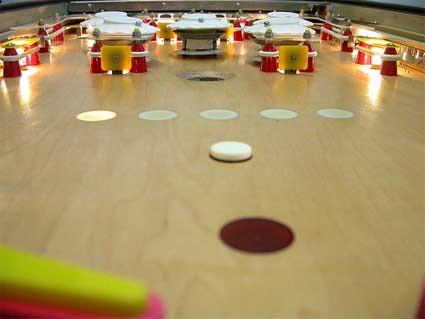
Among the many installations and documentaries i was really looking forward to see at LABoral was Bagatelle Concrete which Martin Pichlmair had mentioned a while ago in an interview i had with him.
Martin teamed up with Viennese artist and researcher Fares Kayali to turn a pinball machine from the ’70s into a musical instrument and, as he explained me at the time, The piece is a pinball machine that constructs music. It samples itself and manipulates those samples according to how you play pinball on it. We removed all competitive and all decorative elements of the pinball game and put digital electronics into this analogue electro-mechanical machine. While the gameplay is technically unaltered – all the bumpers and traps are still in place – the effect of playing is a composition instead of a highscore.
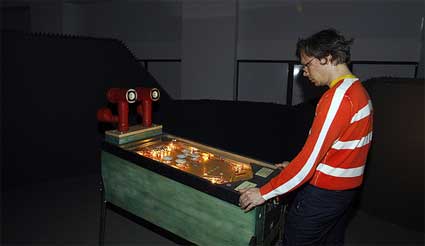
Image credit: LABoral/Enrique G. Cárdenas
The more successfully the player interacts with the machine, the more intense the accompanying soundtrack gets. The piece maintains the roughness of the electromechanical original game, mixing physical sounds happening on the playing field with manipulations of their recordings.
A post written by Nicolas Nova a few days ago brought to my mind what Martin told me in Gijon when i was complaining that that damn pinball was way too difficult to play for me. Apparently the artists had to dumb down the machine. They bought it on eBay, not knowing that the ’70s model was manufactured at a time when pinballs were extremely popular and the models issued had thus to be quite high level to keep players interested.
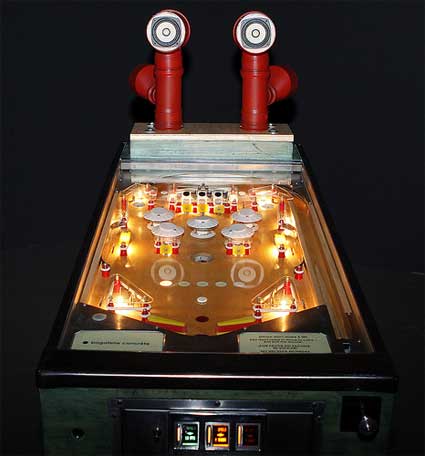
Image credit: LABoral/Enrique G. Cárdenas
Concrète references musique concrète and bagatelle alludes to the history of pinball games. Bagatelle was an ancestor of modern pinball. Created in France for King louis XVI, it looked like a narrowed billiard table. The aim of the game was to get 9 balls past pins (which act as obstacles) into holes.
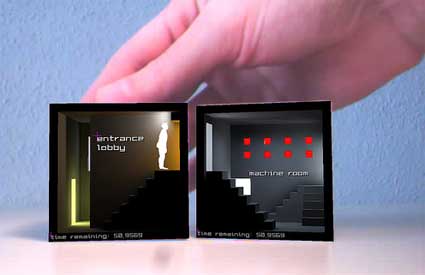
Julian Oliver is participating to the show with an improved version of levelHead, the 3D memory game became an instant youtube and blog hit the moment it hit the online turf. The installation which uses physical cubes as its only interface is totally engrossing and nerve-challenging. On screen it appears that each of the cube’s faces contains a little room and each of them is logically connected with the others by doors. In one of these rooms there is a character and by tilting the cube the player directs this character from room to room in an effort to find the way out. Some doors lead nowhere and will send the character back to the room they started in. levelHead challenges the player’s spatial memory. Each player has 120 seconds to find the exit of each cube and move the character to the next. There are three cubes (levels) in total and, the mnemonic traps become increasingly difficult to avoid as the player progresses.
Video:
The game refers to one of the earliest memory systems which consisted in constructing imaginary architectures (memory loci) designed specifically for the purpose of storing information such that it could be retrieved by ‘walking through’ the building in the mind.
Today, domestic printers, digital tagging systems, address books and journals (on and offline) do the storage and indexing of information in exterior locations like remote databases or local file systems. Similarly, navigating in the real world increasingly tends toward dependence on external media and locative technologies.
With levelHead, moving from one site to another produces an imaginary architecture and positions this memory architecture as the primary means of navigation. Only one side of the cube will reveal a room at any given time and so a memory of the last room – of the positions of entrances and exits, stairs and other features – is necessary to proceed logically to the next movement.
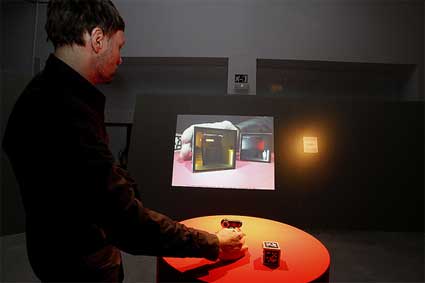
Image credit: LABoral/Enrique G. Cárdenas
The tangible interface aspect is integral to the function of recall. As the cube is turned by the hands in search of correctly adjoining rooms muscle-memory is engaged and, as such, aids the memory as a felt memory of patterns of turns: “that room is two turns to the left when this room is upside down”.
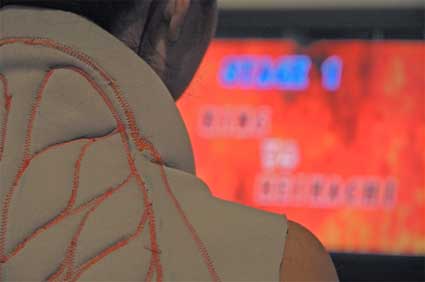
With their Massage me jackets, Hannah Perner-Wilson & Mika Satomi allow massage to enter the video game realm. The jacket is the joystick. By massaging more or less vigourously the back of a volunteer you get to control a fighting avatar. I had fun playing both roles. Being the passive massaged one is extremely relaxing as the designers had spread and repeated the commands all over the back of the jacket, focusing on the areas most likely to beg for a good rub. Now remembering where to massage in order to have your avatar jump or kick requires some practice but playing randomly will not necessarily prevent you from winning the battle.
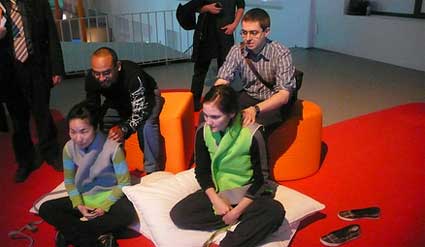
Massage Me session featuring Alessandro Ludovico, founder and editor of Neural magazine
I’m afraid the best piece of the exhibition for me was William Wegman‘s Two Dogs and Ball (Dogs Duet). Wegman has always been a favorite of mine (has someone else seen the Deodorant video? It shows him spraying his armpit with an aerosol deodorant until the can is empty, while giving a deadpan testimonial: “It feels real nice going on, and smells good, and keeps me dry all day.”)
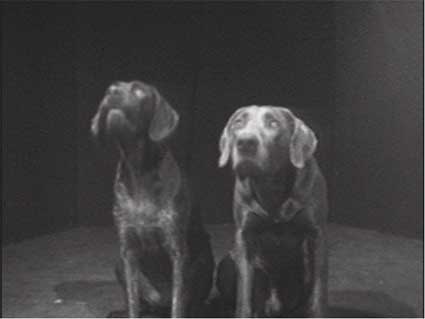
In Two Dogs and a Ball, Wegman’s Weimaraner Man Ray and his companion are mesmerized by a tennis ball which moves off screen. Wegman explained that all he had to do to obtain the comic effect was to move a tennis ball around, off-camera, thus capturing the dogs’ attention.
During the press conference, Laura Baigorri –one of the curators– explained that Wegman’s video has been selected as an example of how the avant-gardes of the 20th century had introduced an element of play in the artistic practice.
The video is on ubuweb.
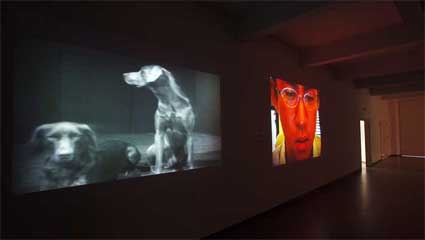
Two Dogs and Ball (Dogs Duet) and Axel Stockburger‘s Tokyo Arcade Warriors – Shibuya. Image credit: LABoral/Enrique G. Cárdenas
My flickr set.
HOMO LUDENS LUDENS runs at Laboral – Center for Art and Industrial Creation in Gijon, Spain (address and google map) until September 22, 2008.
Also part of the Homo Ludens Ludens exhibition: Art of War and El Burbujometro.
Homo Ludens Ludens – Art of War
Posted in: UncategorizedTen days ago i went to the opening of Homo Ludens Ludens the at LABoral Art and Industrial Creation Centre in Gijon, Spain. Homo Ludens Ludens, the third part of a trilogy the center dedicated to games, explores play as a key element of today’ s world.
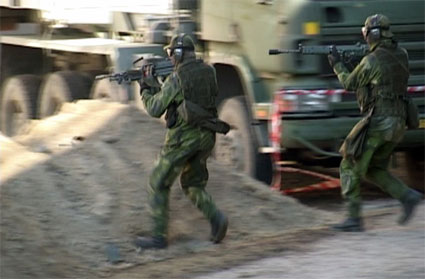
I’ll come back with more details about the exhibition in the next few days but as a smooth prelude to the lengthier coverage, here’s a few words about Art of War Parts 4b and 4c , one of the projects i particularly liked.
Art of War features two puzzling video works. Is that a war movie we are watching? A warzone documentary? A news clip? It’s also almost impossible to identify the date of the events or to locate the city where the fight takes place. It might be Beirut or Sarajevo.
The warzone was downtown Stokholm. It was a Saturday afternoon, in Spring 2006. It wasn’t much of a conflict either, it was a two day army exercise in which lasers were substituted for real bullets and blood and guts are imaginary.
John Paul Bichard (you might remember his beautifully manipulated gamespace interiors) woke up to the sound of heavy machine-gun fire in Stokholm. Armed with a video camera, he recorded the moves of an army whose tanks, troops, APCs and heavy weaponry were simulating a war and using a Saturday afternoon in the city as a battelfield. Right amidst pedestrians, and passing civilian cars and buses…
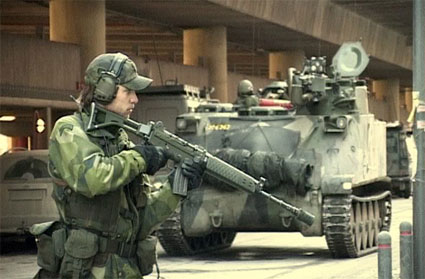
The video works explore the nature of violence and how violent conflict is contextualised in the digital media age. As ‘real’ conflict zones become more restrictive, press access more heavily orchestrated, Bichard constructs an intrusive, voyeuristic commentary on the banality of warfare, the fine line that separates authoritarian control from abuse of power and the ease with which society is incorporated into the mechanisms of institutional violence. Uninvited by the authorities and provided only with earplugs, the works document a thrilling encounter with a grim game.
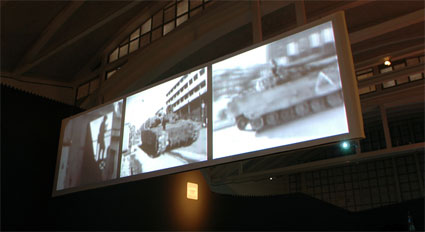
View of the installation at LABoral (image courtesy of the artist)
A couple of questions to John-Paul:
You woke up to the sound of heavy machine-gun fire on morning in Stokholm. It was a complete surprise for you. Still, you grabbed a camera and shot what you saw. At which point did you realize that you wanted to use the footage for an artwork? Was it immediate? Or is it the result of a longer process?
I have played video games so much over the years that my life, the games and my art are in a fluid relationship to each other – so the sound of gunfire was literally a trigger for me. I didn’t have any solid idea at the time as to what I would finally do with the footage but I had previously been doing some short mobile phone video experiments so the seed was already sown. Much of what I do I either intellectually file away or stick in a folder on one of my highly disorganized hard drives so the footage sat on the drives for some months, then one day I just started to go through it. That’s when I rediscovered Edwin‘s music which had also been sitting around for ages – the video and the musical compositions simply made sense when I started combining them.
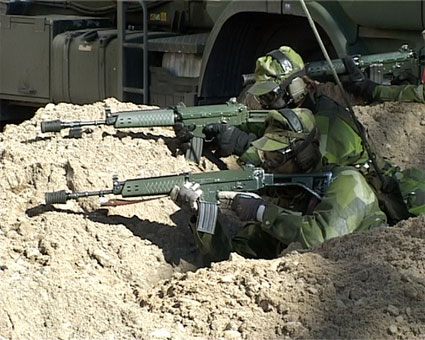
Did you feel like a reporter camera in hands or a gamer while you were in the streets with the soldiers?
Well both really, I guess you could say it was like a war correspondent simulation game: a meta-game to the Swedish army’s anti-terrorist war game on the streets of Stockholm. When i got to the border of the area, i was greeted by soldiers standing at a table – i was a little nervous thinking I would have to sneak around to get some footage, but they just handed me earplugs and told me to keep away from the tanks (which i didn’t and nearly got run over :)). I felt very much like a war cameraman, running from one melee to another. At one point i was shouted at for popping up in the middle of a fire fight – it’s hard to explain the feeling of adrenaline when you have a gun pointed at you or you hear a heavy gunfire down the end of a road even if it is just blanks. I still think it’s amazing that the exercise was so open to the public, but that is not uncommon for Sweden. I can’t imagine the same thing happening in London or Washington DC.
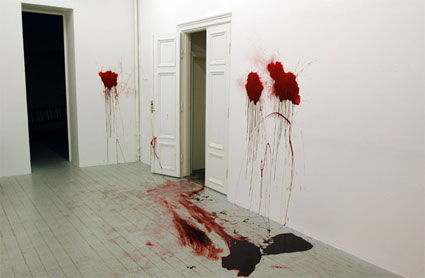
Inverse Forensics, part of the Evidencia series
The work is part of your Violencia series, what is its place in the series? How does it differs and / or what are its common points with the other Violencia art pieces?
Well so far there are two works in the series: [art of game] Art of War Parts 1 to 3 which was shot using a high quality 3 chip DVCAM and [art of game] Art of War Parts 4b + 4c which is a double trilogy made from mobile video clips. These works are only the start of the series which follows on from and expands upon the evidencia series. Whilst the evidencia works looks more directly at the metaphors and tropes of videogames, exploring the aesthetics, ethics and power relationships common in violent games,. the violencia series focuses on exploring our need to consume fictionalised violence and our relationship to institutionalised violence. Whilst Parts 1 to 3 has a more documentary feel to it, the work shown at Laboral is more subtle. Mobile video has a very painterly quality to it and by screening the same trilogy on each side of a panel with one work reversed and in colour, the other in black and white, the scenes become very ambiguous. The footage could have come from Warsaw in 1940, the middle east in the 70s, Bosnia in the 90s, it becomes very hard to place and I like that slippage. Whilst both works are fragmentary narratives, playing with documentary, media and cinematographic tropes, ‘Parts 4b + 4c’ are perhaps a more poignant reminder that whilst a 40million kronor war game was going on in my neighbourhood, not so far away in the world people were waking up to real gunfire on that Saturday morning.
Thanks John-Paul!
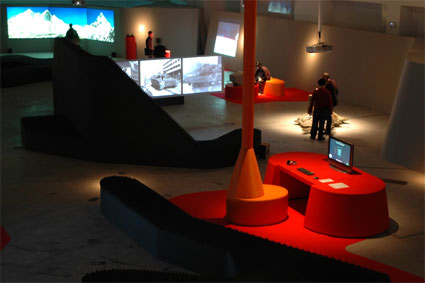
View of the installation at LABoral (image courtesy of the artist)
Homo Ludens Ludens runs until 22nd September 2008. If you manage to get to Gijon before May 12, you’ll also be able to see the Emergentes exhibition dedicated to media art projects developed by Latin American artists (previous reviews: Life inside bubbles, Emergentes – 10 projects by Latin American artists (part 1), and Part 2.)
Art of War parts 1-3 is part of the Try again exhibition, at La Casa Encendida, in Madrid. On view until June 8, 2008.
Also by John-Paul Bichard: Back Seat Gaming.
Yahoo Taps Google, Webby Would-Bes Go Live, BMW Gets Tagged, and the Most Beautiful Marker We’ve Ever Seen
Posted in: Uncategorized
– YAHOO’S PARTNERING WITH GOOGLE FOR SEARCH ADS OMG. Whew. Glad that’s out of the way.
Only in Japan Can Penis Envy Be Solved with a Console
Posted in: Uncategorized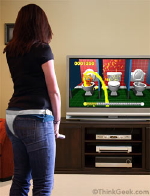
Not a dildo. Not a diaper. It’s a strap-on jimmy for Super Pii Pii Brothers!
Only in Japan Can Penis Envy Be Sated with a Console
Posted in: Uncategorized
Not a dildo. Not a diaper. It’s a strap-on jimmy for Super Pii Pii Brothers!
‘Hazard Lane’ is the Reason Why You’re Going into Foreclosure. Seriously.
Posted in: Uncategorized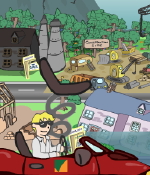
This is a game called Hazard Lane. It was put together by TAMBA for Landmark Information Group. (We like how the title tag says “Landmark Information Group Presents ‘Fair Game'” when the URL is hazardlane.co.uk, and “Hazard Lane” is emblazoned in green across the top of the page. Somebody must’ve missed an email.)
A few words with Wafaa Bilal
Posted in: UncategorizedWafaa Bilal grabbed the attention of the media last year with his performance Domestic Tension. Bilal, born in Iraq and currently teaching at the School of the Art Institute of Chicago, installed his living quarter at Chicago’s Flatfile Gallery. Viewers could peep in on him anonymously 24/7 over a live webcam, chat with him online 24/7 over a live webcam. But the twist was that the camera was affixed to a rifle-sized paintball gun-and online visitors could therefore fire the gun and shoot at the artist, or anything else in his room. 24/7. And according to Newsweek, viewers have shot the gun 40,000 times in the project’s first two and a half weeks. The work brought to Chicago the conditions of bombardment felt by citizens of his homeland.
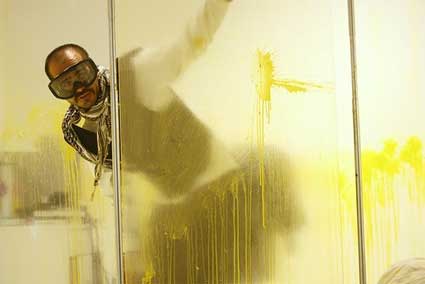
Domestic Tension. Photo Chicago Tribune
In his latest work Virtual Jihadi, Wafaa Bilal reconfigures the Al Qaeda-produced on-line propaganda video game The Night of Bush Capturing to introduce himself a character in the game, a suicide bomber based on an image of a traditional Arab warrior, and turn it into a rumination on the plight and behavior of civilians caught in a conflict zone.
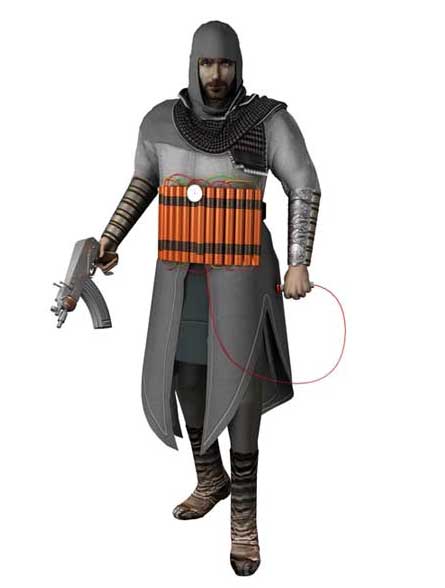
Virtual Jihadi, image courtesy of the artist
Bilal’s mod and installation is based on a 2003 video game called “Quest for Saddam” that involved players fighting stereotypical Iraqi foes and trying to kill the ex-Iraqi leader. The game in turn inspired an al-Qaida-produced spin-off called The Night of Bush Capturing where the U.S. president is the target. For his piece, Bilal hacked into the al-Qaida game and inserted himself as a suicide bomber who is sent on a mission to kill President Bush.

His work is like one of the missing piece of the puzzle, we get some pieces while watching TV news but the picture is not complete and the media often leaves very little space for dialog anyway. I’ll past an extract of the statement from the artist as i think every single word of it is worth reading:
My underlying premise for this piece is that hate is being taught – it’s not a natural emotion. And video games are one of the technologies being used to foster and teach hate. I am especially concerned by the ones created by the US military, which are intended to brainwash and influence young minds to become violent. Though Al Qaeda’s game where Bush is hunted down and killed generated much international outrage, the U.S. Army’s own free on-line game is equal to the Night of Bush Capturing in its propaganda motives. Since I belong to both nations fighting in this current war, and since I am an American, I have the ability and right to question my own government’s use of these video games to teach violence and hatred.
Along with shedding light on the power of video games and their manipulative uses by both Al Qaeda and the U.S. military, I want to show how civilians in war zones find themselves switching allegiances as a means of self-preservation as the balance of power shifts. Their cities are turned into battlegrounds, and survival is often a matter of obeying the power that exists at any given time regardless of any ideology.
This dynamic is apparent in various conflicts around the world, and even in any American inner-city where the gang members have more control than police; and civilians recognize this and refuse to cooperate with the police even if they don’t intrinsically support the gang members. In Afghanistan, Afghani civilians switch sides depending on who is in power. In Iraq people are constantly switching sides. Most Iraqis who support the insurgency do so not because of ideology, but because of their need for security.
The fighting forces in the Iraq war and most wars do not represent the people of either of the warring nations. It’s the fundamentalists – Islamic and evangelical -who fuel this violence, and force civilians to ally with them in order to survive.
So my character in the game will be like any Iraqi civilian on the ground, allying with the power which is dominant at the moment. At the beginning of the game the American soldiers are stronger than Al Qaeda, and I will ally with them, fighting Al Qaeda. But as the game progresses and Al Qaeda becomes more powerful, I will switch sides to fight on behalf of Al Qaeda. That is exactly what is happening in Iraq. The game will culminate with my revenge on the Bush administration for the destruction it has wrought on my country. I will be a suicide bomber who attacks Bush.
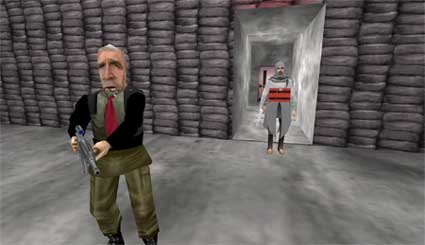
Virtual Jihadi, image courtesy of the artist
Bilal gave a talk last week at the Rensselaer Polytechnical Institute (the video is available online) and an exhibition of Virtual Jihadi opened the same night… to be closed the day after.
Wafaa Bilal’s installation re-opened this week at The Sanctuary for Independent Media, 3361 Sixth Avenue in Troy. The piece was to be on display through April 4, 2008, as part of a month-long celebration of art, freedom and democracy at the Sanctuary.
Unfortunately, one day after the second opening the City of Troy closed the sanctuary due to “code volition.”
Please visit the artist’s website and show your support either by writing a letter to Shirley Jackson president of RPI (president at rpi dot edu). Or add your opinion in the chat room. Brian Holmes wrote a clear and well-balanced post about the situation a few days ago. I’d also like to mention an article in The Guardian which discusses the current lack of appetite for films about the war in Iraq.
When i first contacted Wafaa to get a brief email interview last week, i had no idea his work would be censored and his view would be silenced. I must add that his work came to my attention thanks to an email from members of the RPI arts department who are very supportive of Bilal’s work. Now for your conversation:
What did your previous project Domestic Tension – Shot in Irak teach you? How did you use what you learned during the performance to develop Virtual Jihad?
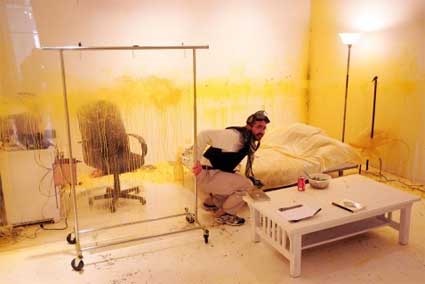
Domestic Tension
WB: It reinforces my notion of the comfort zone versus the conflict zone. Because of image overexposure, we need to come up with smarter tactics and strategies in order to engage people. Otherwise we will continue to exist in the comfort zone while our collective power is taken away by institutions.
In Virtual Jihad, the main character looks like you and carries your name, why do you think it is so important to expose yourself so much personally?
WB: I wanted to place it in the context of reality, the need to reflect life in art. What better way to reflect what Iraqis are going through than a personal tragedy, casting myself as a suicide bomber after the killing of my brother. I represent so many Iraqis who find themselves vulnerable to a terrorist organization like Al Qaeda taking over their homeland. They either become violent because of the pressure or they are forced to join these organizations out of fear or they join because of their outrage at what the U.S. is doing to their homeland.
Why do you use video games as a medium for your interventions? What makes them more powerful or more adapted to the kind of discourse you are engaged in?
WB: Because video games have become the medium of our time, so many people use this popular medium to convey a message. With video games, people are engaged beyond art, their senses are engaged.
Showing your works must be challenging for art venues because all the media attention (and probably mis-understanding) they get. What is the experience you have with exhibition spaces?
WB: We are certainly experiencing the problem of an artist versus the establishment. We are using the power of the internet as an encounter. The internet levels the playing field. Video games are becoming more and more powerful because they bypass the censorship of institutions.
Your work has very controversial undertones. How much do you think this helps and/or impedes the audience to understand the message your work is carrying?
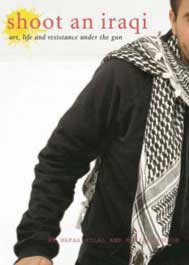 WB: Sometimes the project itself becomes the trigger for the dialog. I’m not necessarily interested in imposing ideas or having a project that is dogmatic. I want the conversation to be carried on outside the gallery walls. The purpose is not art itself but the conversation it triggers
WB: Sometimes the project itself becomes the trigger for the dialog. I’m not necessarily interested in imposing ideas or having a project that is dogmatic. I want the conversation to be carried on outside the gallery walls. The purpose is not art itself but the conversation it triggers
Can you tell us something about your upcoming book? What will it be about?
WB: It is called “Shoot an Iraqi: Life, Art, Resistance under the Gun” to be released in Fall 2008 on City Lights Press. It is basically a dual narrative of my Domestic Tension paintball project last Summer and my life in Iraq and the U.S.
Thanks Wafaa!
However, Wafaa still has one project going on. Online! Run to Dog or Iraqi and cast your vote to decide which one — a dog named “Buddy,” or an Iraqi, himself — will be waterboarded at an “undisclosed location” in upstate New York. Waterboarding is a form of torture which dates back to the Spanish Inquisition. The person is immobilized on their back with the head inclined downward,, and water is poured over the face and into the breathing passages. Through forced suffocation and inhalation of water, the subject experiences the process of drowning and is made to believe that death is imminent. The person would (usually) be “resuscitated” at the last moment

Dog or Iraqi
A doctor and a vet will be on hand to minimize the risk of death to the dog or the human being. At the time i spoke with Wafaa, the dog was the clear winner of the contest!
I’ll leave you with this video interview of Wafaa commenting on the RPI censorship:
Cartoon Network Goes Viral!
Posted in: UncategorizedImage of the day
Posted in: UncategorizedWas taken last week at the Salk Institute for Biological Studies at La Jolla, California which Kati London and I visited courtesy of Lev Manovich and Jeremy Douglass. The institute was built by architect Louis Kahn as two symmetric concrete buildings with a thin stream of water flowing in the middle of a courtyard that separates the two. Too bad my images don’t do justice to this amazing building.
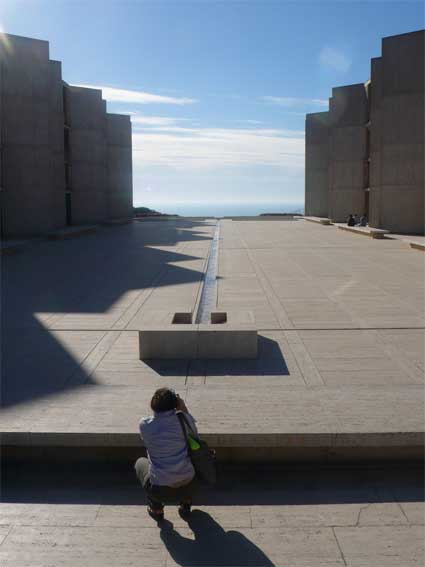
I find it hard to believe that no one has ever shot a movie there. Elio Petri would have done something amazing with this set.
Anyway, any solemn thought and sense of beauty we might have been filled with vanished half an hour after when we met with Mary Flanagan‘s Giant Joystick which is on view until March 17 in the art gallery in the Calit2 building at UCSD.
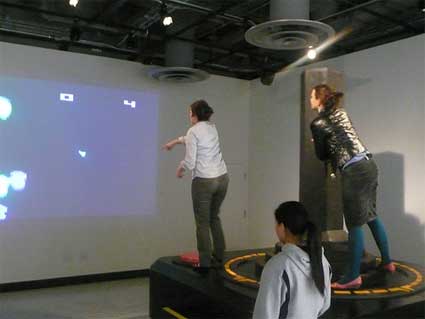
Extremely fun and physically exhausting.
Street Fighter 4 (Trailer II)
Posted in: Uncategorized
The first trailer was with Ryu and Ken. Now was the turn for two women.
Awesome effects.
Via: ComputerLove.



